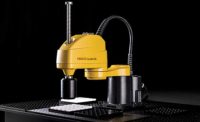For many manufacturers, efforts to build the next-generation workforce feel like a plot from “Mission Impossible.”
It’s estimated that nearly 3.5 million manufacturing jobs will be needed over the next 10 years, but more than half of them will go unfilled due to a shortage in qualified applicants for skilled production roles. Already, some 80 percent of manufacturers are struggling to bring new talent into the door and up through the ranks. Add to that a U.S. unemployment rate of 4.9 percent, which means more competition for skilled candidates.
At the same time, manufacturers face an aging workforce, who may retire without sharing the key knowledge in their heads. In fact, the Pew Research Center predicts that 10,000 baby boomers will retire each day over the next 19 years. Then, toss in the fact that most management teams are boomers and Gen Xers with different world views from those held by millennials, frequently resulting in misalignments of priorities, work preferences, perspectives and motivations.
No doubt, it’s a complex challenge for which there is no single solution. However, a number of innovative manufacturers, generational researchers and talent acquisition professionals have developed effective strategies for attracting, engaging, developing, and retaining the team members who will be central to driving manufacturers’ businesses forward.
Here is a look at the most promising of those strategies.
Give Manufacturing an Image Refresh
Attracting a new generation of employees means changing outdated preconceptions of manufacturing. It is surprising how many people visualize a manufacturing floor straight out of the industrial age, despite several decades of advances. They have little understanding of how state-of-the-art technologies, such as computer-aided design, 3D printing, robotics and CNC machining, drive modern manufacturing operations.
Manufacturers should consider implementing initiatives to engage with the community, whether it involves regularly scheduled manufacturing tours, joint career education initiatives at colleges and high schools, virtual events, or social media engagement.
One of the best platforms for educating students and parents is Manufacturing Day, which aims to address misperceptions by showing what manufacturing is—and isn’t. It provides opportunities for manufacturers to participate in existing events that bring together multiple companies or to even host an event of their own. Last October, some 2,809 events across North America were held around Manufacturing Day 2016. (For more information on Manufacturing Day, visit www.mfgday.com.)
However, Manufacturing Day initiatives extend beyond the official date. In fact, Edge Factor believes every day is Manufacturing Day. To help companies plan their own event, the e-learning company has produced a Rock MFG Day Kit, which features cinematic media and interactive resources for promoting and hosting an event to change perceptions of manufacturing.
Manufacturers also must do more than promote the “cool-factor” of today’s technologies. They need to communicate the educational requirements for succeeding in manufacturing careers, so that students can understand the skills they will need. Additionally, with millennials’ desire to make a difference, manufacturers should provide insights into how employees can contribute to the success of the company and customers, as well as participate in any corporate causes.
Importantly, manufacturers should not limit their recruiting efforts to millennials. Although this generation will be key to long-term growth, many Gen Xers are seeking new opportunities or career shifts. Gen Xers are tech-literate, and the youngest of the generation will be in the labor market for another 25 to 30 years. Equally important, with many having started families, Gen Xers tend to value job stability. By contrast, research indicates that more than 90 percent of millennial workers will leave a job after less than three years.
Invest in Internships and Education
Whether recruiting millennials or Gen Xers, many industries require specialized expertise that is difficult to learn in a classroom or doesn’t transfer well from other job experiences. Some high schools and manufacturing sectors are working together to combine core science, technology, engineering and mathematics (STEM) classes with internships that help students develop specialized skills.
“Long term, I think one of the solutions is to put more manufacturing and engineering education back into the schools to create an employment ramp right out of high school,” observes Denise Hummel, human resources manager at Linn Products Inc.
One of the best examples of education-industry collaboration is Aviation High School. Accredited by the Federal Aviation Administration, the school works with John F. Kennedy International Airport to provide airline maintenance certification. Some 2,200 students take standard high school classes, but they also attend courses on the mechanics of how a jet airplane operates and get hands-on maintenance experience—with assistance from a number of commercial airlines. When students graduate, they earn both a diploma and a certificate to work in the aviation industry.
However, manufacturers do not need to be Fortune 500 companies to conduct internships. Many mom-and-pop shops and midsize firms also offer part-time after-school jobs and individual internships through partnerships with local high schools and community colleges.
Other manufacturers work with government agencies, career assistance organizations or other nonprofits. One example in California is the nonprofit organization, Swords to Plowshares, which among other services, provides veterans with employment, training, and educational opportunities. Companies may find that they qualify for federal, state and local economic development funds to create skilled-trades apprenticeship training programs.
Notably, the subsidiary of midsize manufacturer PTC, 50 Strong, is taking another approach. It has launched the 50 Strong Foundation, which awards scholarships to those interested in pursuing careers in manufacturing. The scholarship assists recipients with the cost of attending a technical, vocational or trade school to enhance their manufacturing skills and knowledge.
Engage Employees Across Generations
Retaining employees means getting off to strong start from day one. Too many manufacturers have learned this the hard way, when new hires walk away after just weeks on the job. Millennials, in particular, want to tackle new challenges and opportunities, and boredom is a deal-breaker. This is good news for manufacturing, which thrives on innovation. Additionally, members of this generation feel a need to be involved, are used to flexible schedules, and want to know that their work is meaningful.
“Millennials are certainly used to controlling their own time. The shop floor doesn’t always allow for that. But it’s not just the younger generation; it’s the management style that needs to adjust too,” Hummel explains. “Finding ways to create more flexibility in the workday routine, learning new styles and methods of effective communication, and automating manufacturing to create technology jobs are of great interest to the millennial generation.”
Manufacturers should be prepared to assign meaningful responsibilities to new employees, not simply have them “pay their dues” with menial tasks. When there is a real need for new hires to assist in administrative cleanup, managers should provide a perspective on how this less-than-exciting work helps colleagues and even customers.
Management teams should also seek to engage employees, whether millennials or Gen Xers, by asking them to consider developmental assignments in different areas of the company, listening to their goals and hopes for enrichment or advancement, and then mapping out personalized career plans with them. Manufacturers should also consider assigning members of senior management to serve as mentors to employees and advise them on how to add more value to their work and the business. Importantly, mentoring shouldn’t be limited to new hires; it can also unlock untapped potential among current employees.
Beyond formal mentorship, consider establishing cross-generational project teams or special committees. Newer employees can gain important knowledge and build their skill sets from senior team leads. Meanwhile more experienced employees should be encouraged to take advantage of the enthusiasm, creativity and comfort with technology that the younger generation brings.
To ensure the success of teams, it is important for everyone to recognize the different values and motivators for each generation and appreciate that no one perspective is best. Millennials tend to be collaborative and tech-savvy, and they desire to make a difference early in their tenure. Meanwhile, Gen Xers usually are self-reliant and analytical, and they want a work-life balance. Boomers bring a strong work ethic, focus on process, desire personal gratification, and are determined to perform well. Like millennials, they tend to be optimistic. Senior management, in particular, should incorporate this understanding in strategies to create a culture, policies and plans that empower members of each generation to be successful contributors.
Embrace Technology
Cross-generational teams help foster knowledge transfer from the baby boomers, who are thinking about retiring, to younger team members. Additionally, technology plays an important role in communications and information exchange. This is particularly true for millennials, the first generation to have grown up with text messages and social media.
With so much company information stored in the heads of boomers, it’s also important to invest in technology to capture this vital knowledge. This may take the form of audio and video recordings of employees explaining key processes or a document management system that catalogs and stores work instructions and other data.
Manufacturers can reap numerous benefits from making such technology investments. Housing up-to-date “how we correctly do things here” instructions in a logical, easy-to-access system will improve training results for both new employees and existing ones migrating to a new group. Also, using the same document system to create single versions of the truth for processes and projects will reduce doubt and frustration, and save time for current and future team members. Additionally, many modern enterprise resource planning systems help minimize the redundant work that frustrates all employees.
Finally, using technology will make the work environment more appealing to tech-savvy millennial and Gen X employees. They rely on smartphones, tablets and Web apps that store, organize, search and display information on an almost unlimited number of topics in business and technology, and they want to have the same power and flexibility at work. By empowering all team members to become more productive, manufacturers not only improve their operations, but also create an environment that encourages valued employees to stay.









